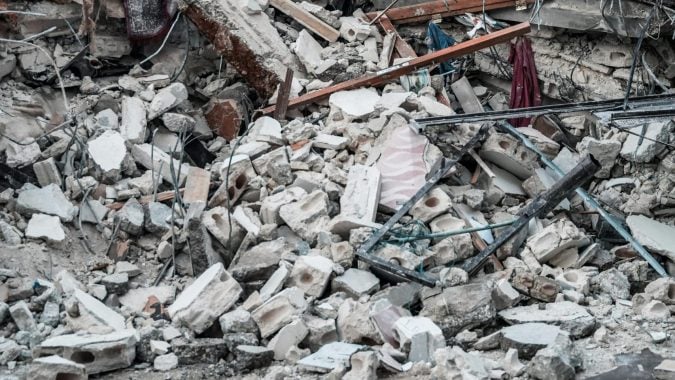Earthquake lays bare climate change, disasters connection

Friday’s devastating earthquake in central Myanmar, whose disastrous impacts were felt as far as Thailand and China, has reaffirmed the interface between disaster risks and climate change.
It also shows how tragedies caused by such disasters require integrating disaster risk reduction (DRR) strategies with a social cohesion element, early warning systems, a culture of anticipatory action, and even political will and stability, for effective response.
More extreme weather events are those natural hazards where climate change adaptation and DRR overlap. Both need to focus on the whole risk management cycle, including prevention, preparedness and recovery measures.
The synergies between policies on disaster management and climate change adaptation both need to be streamlined throughout policies on water (floods, droughts) or on critical infrastructures.
Disaster risk management (DRM) is a global concern, with international organisations like the United Nations and the World Bank playing a key role in promoting and supporting DRM as in the recent earthquake.
Former UN Secretary-General’s Special Representative for Disaster Reduction, Mami Mizutori, emphasised the need for integrating DRR and climate change adaptation in the UN sustainable development cooperation framework.
Shocks impoverish
A World Bank study of 89 countries cited in the Global Assessment Report for Disaster Risk Reduction 2019, found that if all disasters were to be prevented in one year, the number of people living in extreme poverty – those living on less than US$1.90 a day – would fall by 26 million.
According to Mizutori, millions of people are falling back into poverty each year due to shocks ranging from both localised severe weather to major disaster events such as drought, floods and storms and, as demonstrated by Covid-19, pandemic and epidemic disease.
“Environmental changes driven by climate change and unsustainable exploitation of the earth’s resources are rendering many people and ecosystems ever more vulnerable thus increasing the scale and frequency of hazards,” said Mizutori.
She went on to explain how risk-blind investments and development choices weave hazards, exposure and economic, social and environmental vulnerabilities together into an intricate interlock of disaster risk. This in turn, she said, creates a systematic pattern of disaster risk now eroding development processes across all sectors.
The projected increase of 3.2 degree Celsius in the global climate is estimated to cause “once-in-one-hundred-year” events to occur every decade and threatens to render existing risk management strategies obsolete.
The disastrous earthquake that measured 7.7 on the Richter Scale left hundreds dead and massive destruction in its wake. Unstable buildings in cities near the epicentre of the earthquake in Myanmar collapsed, and historic buildings in the once royal capital of Mandalay and Myanmar’s second largest city, were heavily damaged.
In Thailand, a huge rescue operation continued at the site of a collapsed high-rise building in the capital Bangkok. where seven construction workers were confirmed dead within hours of the earthquake, as scores remained missing.
Drones, sniffer dogs and diggers searched the rubble for life. Cranes and diggers were brought in, but the mountain of debris is absolutely enormous and at least 10 storeys tall, dwarfing the rescue workers below.
Queues, closures and traffic marked the difficult transport situation in Bangkok. Most major public transport systems, including the popular SkyTrain and subway, shut down and only buses were running.
Traffic on the roads was badly congested, and many people were stuck in their offices with no way to get home. The collapsed building – the new headquarters for the auditor-general’s office – is situated just across from one of Bangkok’s popular tourist attractions – Chatuchak market.
Tumultuous history
The military junta in control of Myanmar announced a state of emergency in Mandalay, Sagaing, Magway, North-eastern Shan, and Bango regions and in an unprecedented move appealed for international assistance in the wake of the quake.
Myanmar (previously known as Burma) has experienced decades of conflict and repressive military rule since it gained independence from Britain in 1948. It spent decades under military rule from 1962 to 2011, and was a pariah state subject to severe international sanctions.
However, the country gradually began to liberalise and transition to a democracy. A nominally civilian government was introduced in 2015, and historic elections took place. National League for Democracy (NLD), the party of opposition leader Aung San Suu Kyi, who had spent years in prison during military rile, won the vote by a landslide.
The military still retained significant political power, however, and in 2021 Myanmar’s transition towards democracy was cut short when it seized power in a coup. The coup was widely opposed by the public who took to the streets nationwide in mass protests. The military responded with deadly force, and began arresting anyone suspected of criticising its rule.
In response, many civilians joined so-called people’s defence forces, to fight against it. Fighting has spiralled across much of the country, including parts of the centre, which had rarely seen conflict in previous decades.
The sheer number of groups fighting against the military has left the generals severely overstretched. It has endured the most humiliating defeats in its history, losing huge swathes of territory including along the borders with China and Bangladesh.
Dozens of towns and military battalions and even two regional commands have been lost, reported the respected UK newspaper, The Guardian.
A BBC study estimates the military controls just 21 per cent of Myanmar’s territory. It has been accused of repeatedly bombing civilian sites, including schools and hospitals, torching villages, carrying out mass killings, and torturing its opponents in a desperate attempt to cling to power.
Calls for the resignation of the junta chief, Min Aung Hlaing, have grown among pro-military circles. However, he shows no signs of backing down.
The military has promised elections this year, but is unclear how it will implement these given that large areas of the country are controlled by its opponents – a situation now complicated further by the devastating earthquake.
A spokesperson for the United Nations refugee agency, UNHCR, told the BBC that it is still trying to understand the full extent of the earthquake damage, but was ready to provide help, including shelter and household items as soon as safe routes to Mandalay are secured.
Diego Alcantara, based in the capital Yangon in the south of the country, told BBC that around 1.6 million people displaced by ongoing conflict are living in central and north-western Myanmar, and the disaster would no doubt exacerbate their hardships.
“This disaster, combined with an intensified armed conflict in a country that is vulnerable to climate change, makes civilians pay an enormous price,” he noted.
“And this growing humanitarian assistance comes at a moment of shrinking funding, putting the humanitarian organisations, including UNHCR, in a hard-to-impossible exercise of prioritisation”.
Disaster risk management (DRM) encompasses all aspects of managing disasters and disaster risk in a holistic approach, including prevention, mitigation, preparedness, response, and recovery, aiming to reduce disaster losses and strengthen resilience.
DRM is a comprehensive strategy that considers all phases of a disaster lifecycles, from prevention to recovery as has happened in Myanmar, with repercussions in Thailand and China. A key goal of DRM is to build resilience, meaning the ability of individuals, communities, and systems to withstand and recover from disasters.












